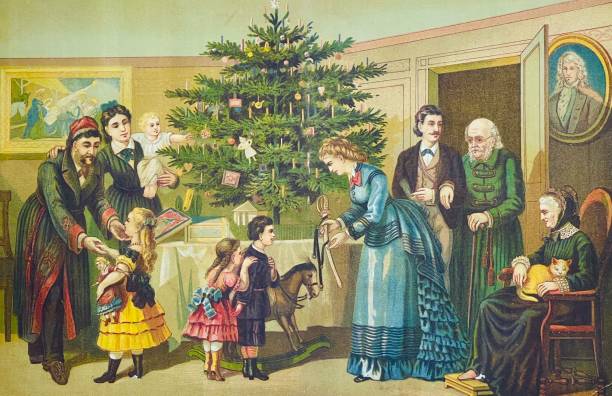The Victorians brought about many beloved Christmas traditions that are still celebrated today. However, there are some that have been lost to time.
I live in a Victorian house, and this year, I thought I would bring some of these traditions back into our home this Christmas. Maybe you would like to choose a few and do the same.
Exploring the Dark Side: Macabre and Humorous Victorian Christmas Cards
Christmas cards were invented by Sir Henry Cole, a British civil servant and inventor, in 1843. He commissioned the artist John Callcott Horsley to create the first Christmas card, which depicted a family enjoying a festive meal and included the message, “A Merry Christmas and a Happy New Year to You.”
While Victorian Christmas cards were generally festive and cheerful, there were some that were morbid or dark-themed. These cards often featured dark or humorous illustrations that played on the Victorian fascination with death and the macabre. Some of these cards depicted dead Robins, ghosts, or other creepy things.

I think I will give this one a miss and stick to cheery ones!
Victorian Christmas Eve: From Carols to Ghost Stories
Christmas decorations were an important part of Victorian Christmas celebrations. The Christmas tree was the focal point, typically adorned with candles, handmade ornaments, and garlands made of paper or popcorn. The tree was often placed in the parlour or drawing room, and its unveiling on Christmas Eve was a highly anticipated event. The introduction of the Christmas tree is often credited to Queen Victoria and her German husband, Prince Albert. Prince Albert brought the custom of decorating a Christmas tree to the royal household in the 1840s.

Carol singing was a cherished tradition on Christmas Eve. Singing was not only a way to spread holiday cheer but also a means for the less fortunate to earn some extra money during the festive season.
Ghost Stories: Telling ghost stories on Christmas Eve was a popular Victorian tradition. Families would gather around the fireplace or in a dimly lit room and share spooky tales. This tradition was influenced by the popularity of Gothic literature during the Victorian era, with authors like Charles Dickens contributing to the fascination with ghostly tales.
This is my favourite and one that will be happening in my house.
Christmas Day: A Day of Elegance and Merriment
The Christmas meal was a grand affair filled with indulgent and hearty dishes. The centrepiece of the meal was often a roasted turkey or goose, accompanied by flavourful stuffing made with breadcrumbs, herbs, and sometimes fruits. Rich and savoury gravy made from the pan drippings of the roasted meat was served alongside. Traditional vegetables like roasted potatoes, carrots, parsnips, Brussels sprouts, and peas were commonly served as side dishes. They didn’t forget the cranberry sauce.
For dessert, mince pies were a popular choice. Another favourite was the Christmas pudding, served with a flaming brandy sauce. Trifle was also enjoyed. Assorted nuts, dried fruits, and sweets like marzipan and sugarplums were served as snacks or decorations.
The shape of Victorian mince pies resembled coffins! Hold your horses a little while I explain!During the Victorian era, death and mourning were significant aspects of society, and many customs and traditions were influenced by this somber theme. The coffin shape of mince pies was believed to represent the manger in which baby Jesus was laid, foreshadowing his eventual death and resurrection.
After the Christmas meal, families would engage in various games and entertainment. These included charades, card games, singing carols, and storytelling.
The True Meaning of Boxing Day: A Legacy of Charity and Community
Boxing Day, celebrated on December 26th, has its roots in Victorian traditions of charity and community spirit. The name derives from the practice of using alms boxes, where churches collected donations throughout the year to support the less fortunate. On this day, these funds were distributed to those in need, reflecting a commitment to social responsibility. Additionally, wealthy families would prepare Christmas boxes filled with gifts and leftover food for their servants and tradespeople, acknowledging their hard work and dedication. If you were lucky, you may have gotten the day off to see family.This practice not only provided a moment of gratitude but also reinforced community bonds, emphasising the importance of kindness and generosity during the festive season. In essence, Boxing Day was a celebration of giving back and sharing the Christmas spirit with those who served and supported others throughout the year.
Read more Yule tales.

Victorian Christmas by Lucinda Dickens Hawksley Yes, she is a descendant of Charles Dickens!
